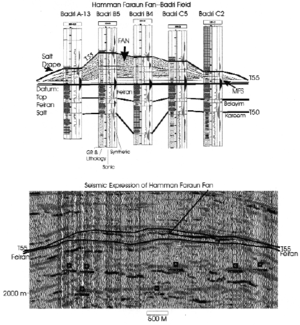Combining well log with seismic sequence analysis
| Exploring for Oil and Gas Traps | |

| |
| Series | Treatise in Petroleum Geology |
|---|---|
| Part | Predicting the occurrence of oil and gas traps |
| Chapter | Exploring for stratigraphic traps |
| Author | John C. Dolson, Mike S. Bahorich, Rick C. Tobin, Edward A. Beaumont, Louis J. Terlikoski, Michael L. Hendricks |
| Link | Web page |
| Store | AAPG Store |
By interpreting depositional sequences in the seismic and well log data separately, discontinuities are identified as objectively as possible on the seismic and log sections before they are tied together using the synthetic seismogram.[1]
Objectives

After well logs and seismic sections have been analyzed for sequences, well log and seismic interpretations should be tied together by generating a synthetic seismogram from log information. There are two primary objectives to this step:[1]
- To link well log depths to seismic section times.
- To develop an understanding of the causes of constructive and destructive interference patterns of individual wavelets originating from acoustic impedance contrasts.
Using synthetic seismograms
The composite synthetic seismic trace from a synthetic seismogram relates depth information from logs to seismic time. The plots of individual wavelets in a synthetic seismogram show how each impedance interface contributes to the individual reflections. Vail[1]) recommends that seismic sequence analysis and well log sequence analysis be started independently so that boundaries be interpreted as objectively as possible before they are tied together by a synthetic seismogram.
Figure 1 is an example of a synthetic seismogram from the Midland basin, Texas.
Procedure

Follow this procedure from Vail[1] to tie well log information to seismic data.
- Generate a synthetic seismogram from log information (Figure 1) using the appropriate software or by asking an expert to create one.
- Tie well log information to seismic data using the synthetic seismogram.
- Adjust depositional sequence and systems tract boundaries to the best solution using the ties made in step 2.
Example of integrating synthetics
Synthetic seismograms, or synthetics, can be interactively tied to log, lithologic, and seismic data on geological workstations. Figure 2 illustrates an example from the Gulf of Suez basin. A wavelet trough forms at a sequence boundary (T55) overlain and sealed by anhydrite and salt. A pronounced wavelet peak forms on an underlying maximum flooding surface. The intervening sequence consists of a lobate deltaic fan formed during a relative highstand. The transgressive systems tract is thin to absent. The geometry of the fan is clear from the well log and seismic integration.
See also
- Geometrical analysis
- Procedure for geometrical analysis
- Other correlation features
- Seismic sequence analysis
- Well log sequence analysis
References
- ↑ 1.0 1.1 1.2 1.3 1.4 Vail, P. R., 1987, Seismic stratigraphy interpretation procedure, in A. W. Bally, ed., Atlas of Seismic Stratigraphy: AAPG Studies in Geology No. 27, p. 2.
- ↑ Ramzy, M., B. Steer, F. Abu-Shadi, M. Schlorholtz, J. Mika, J. C. Dolson, and M. Zinger, 1996, Gulf of Suez rift basin sequence models--Part B: Miocene sequence stratigraphy and exploration significance in the central and southern Gulf gf Suez: Proceedings of the 13th Petroleum Conference, the Egyptian General Petroleum Corp., vol. 2, p. 242-256